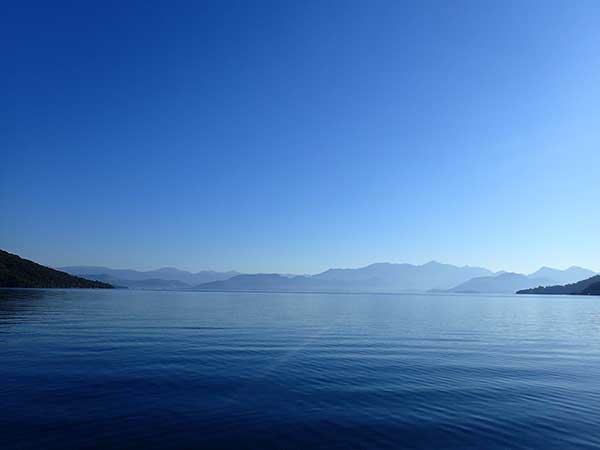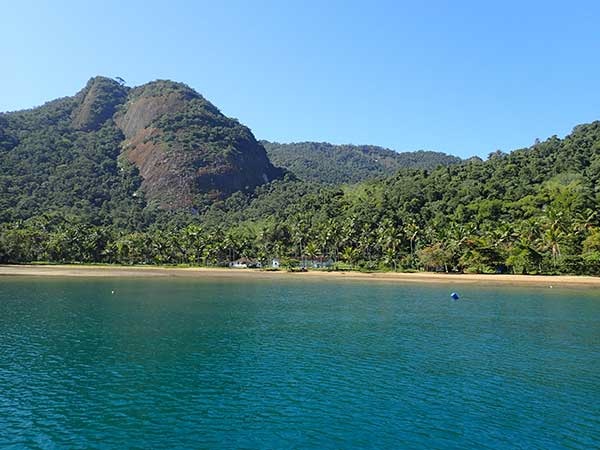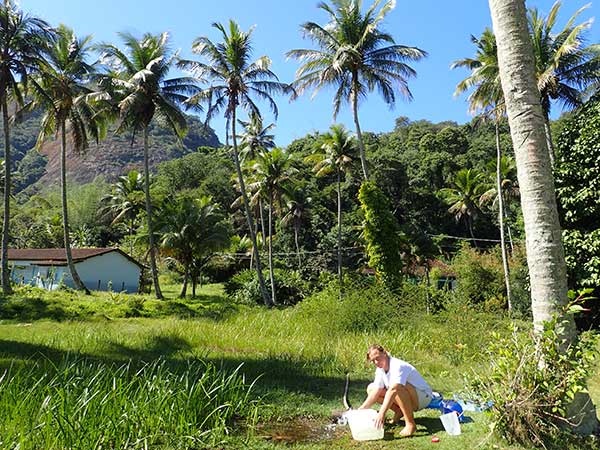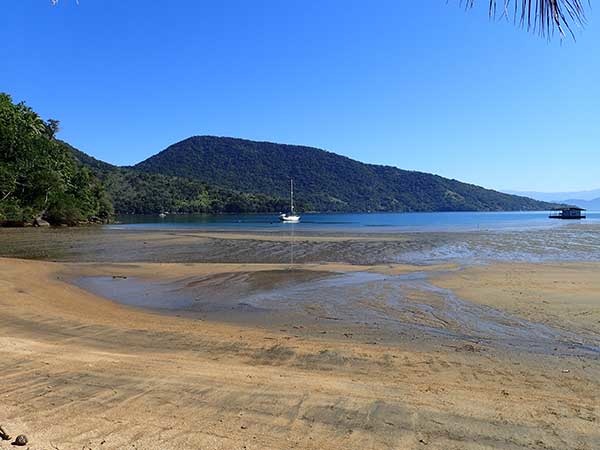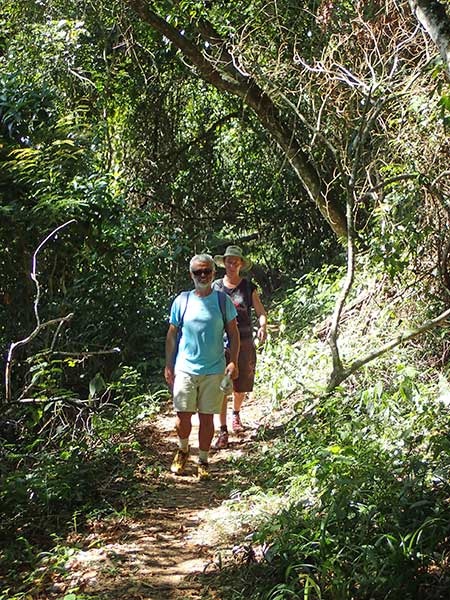Ilha Grande - Sailing around Big Island

Caramor - sailing around the world
Franco Ferrero / Kath Mcnulty
Sun 9 Aug 2015 20:39
Ilha Grande is a 'cliché' tropical island paradise. Warm all year round, good soils, bountiful tropical fruit, clear water full of fish and not much to do. Today few of the inhabitants rely entirely on subsistence agriculture as tourism has brought welcome cash without destroying the environment.
Conditions on Ilha Grande haven't always been idyllic, however. The Portuguese first arrived towards the end of the 16th century and started clearing the mata atlantica (Atlantic rainforest) which covered the whole of the island, they coveted the red pigment extractable from Brazilwood trees. The Tupi-Guarani native people who lived on the mainland and hunted on Ilha Grande looked on in puzzlement; they simply couldn't understand how a dead tree taken back to Europe could be more valuable than a live tree in the forest which would bear fruit for future generations.
The loggers were followed by large farmers who planted coffee and sugar cane on the cleared slopes of the island, only the jungle on the higher reaches was spared. Slavery was an integral part of plantation management and when the British abolished slavery in the 19th century and the Royal Navy was enforcing the ban on the slave trade, which Brazil had signed up to, the farmers on Ilha Grande tapped into a very lucrative business: slave smuggling using Ilha Grande as a way into Brazil. At the end of the 19th century, the coffee growing boom came to an end and two large farms at the eastern end of the island (Abraão) were sold to the emperor. The western end of Ilha Grande reverted to small subsistence farming and the forest had a chance to regrow.
Our first 'port of call' back on the island was Saco de Céu, meaning 'Cove of the Sky' in Portuguese. It is so protected that on a still night, the water is so calm that the stars are reflected in the bay ... or so the story goes. There are so many lights from restaurants and houses now that you are hard pushed to see the stars above, let alone the stars below.
We found a pleasant spot, just inside the entrance with only one restaurant. As the sun was setting and the power boats were speeding back to their moorings on the mainland, we were looking forward to a peaceful evening listening to the noises of the jungle. "One, two, one, two, testing, testing" came the amplified sound checks from the restaurant. A band started playing and minutes later an escuna arrived and disgorged its cargo of revellers.
'Our spot' in Saco de Céu
The music sounded vaguely like jazz and the flute and guitar didn't seem to be playing the same tune. From the forest above the restaurant, we heard a rasping sound ... howler monkeys! We first heard howler monkeys when my mother was visiting and we were anchored off Abraão. Franco had recognised the sound but I didn't believe him. How could such a sound be made by animals? it sounded like a JCB scraping rock, how could it possibly be monkeys? As the group approached, we were able to distinguish individual barks. The diners remained totally oblivious to the primate chorus.
Early the next morning we moved on to the Blue Lagoon (remember that corny romantic film? I loved it!). The water was very clear and we snorkelled in the coral shallows among thousands of colourful fish.
Lagoa Azul (Blue Lagoon)
The trouble with paradise is that everybody wants a piece of it!
Blue Lagoon by 11am on a busy Saturday
We expected everywhere to be bustling with motor boats but just a few miles further west was a lot more peaceful.
At Sitio Forte, our anchorage for a couple of nights, the building next to the school looked like it might be a bar. An old man in a Brazilian football t-shirt took our orders. We struggled to understand his Portuguese but could just pick up enough to keep the conversation flowing. He told us that he was born in Sitio Forte and had lived there all his life. Now that he is elderly he puts feed out for the birds and 'nest boxes' up in the trees. These consist of a large section of bamboo, tied horizontally to the trunk about two metres above the ground. He told us they were for 'land ducks'. He's proud of his son who owns the floating bar.
Sitio Forte
A dugout canoe with an inboard engine - Sitio Forte
The next day I was on water duty while Franco checked the engine. I rowed in to fill our water bottles from the spring. As the tide was going out, I moved the dinghy and all the bottles to the water's edge, then quickly, I loaded all 140kg of water onto Ding and jumped in. Too slow. The water had retreated further, leaving us stuck on the sand. The next ten minutes were like a comedy sketch. I would unload the dinghy, dash down the beach with the bottles, drag the dinghy, load up ... too late, again. The old man came running. We loaded up the dinghy, he told me to get in and he pushed all 210kg of us down the beach to the water!
Kath collecting water
Sitio Forte; a shallow bay with Caramor and the floating bar
On our way through the forest to Bananal, we walked past Matariz, a wattle and daub village untouched by tourism. Chaos reigned as a dog chased the chickens feeding along the dirt path. We passed a bar and the barman waved enthusiastically. On the beach stood the ruins of the last sardine cannery to close. A shirtless man walked with us, patting his fat belly. He asked us where we going and showed us the path.
A toad on the path
We turned back above Bananal, a village mostly inhabited by Japanese settlers and their descendants. They came to Brazil and built the sardine canning businesses. On the way back we stopped at the bar in Matariz. A game of pool was progressing in earnest and it was hard not to get in the way of the cue when ordering at the bar. We asked for a soft drink. The choice was beer or rum. The friendly barman told us he had lived in Matariz since 1954. His children were grown up and his wife had gone to heaven so it was just him now. I said: "Things must have changed a lot since then?" "No, not a lot." What about the tourists?" I asked. "They come, they go." he replied. Meanwhile the pool game had finished. A couple of men in the corner approached us with wriggly bits on forks that they were intent on feeding us; whelks. We tried one, it wasn't as bad as I had expected. Two of the pool players told me that they compete in local championships. Did we want more whelks? or the sea urchin or the crab? "Both are delicious" we were told. Time to go, we didn't want to get benighted in the jungle.
Praia Vermelha (Red Beach) is beautiful. A small beach with large boulders and good holding for the anchor. We swam ashore and met Thomas and Anja, whose sailing boat 'Robusta' was in the next bay. At last we meet! We first saw Robusta in the Cape Verde Islands then again at Itaparica in Aprill but had never managed to meet the crew. They are from Schaffhausen in Switzerland.
The little cove off Praia Vermelha
Robusta off Praia Vermelha
Anja came with us the next day to the cave at the end of the island. It was a very hot and parts of the path were in the open. We passed several small holdings before entering the forest. On a branch way up above the trees, a marmoset was doing a "Bagheera" impression. This tiny creature was trying to intimidate Franco by whistling at him. After an hour's walk we came to a very old wooden gate across the path. We walked down to a house. An old man wearing a faded t-shirt on his head as protection from the sun told us it was 30 Reais to visit the cave and 45 Reais with a guide. We hadn't expected to be charged so were a little taken aback. "We don't need a guide, thank you". "I'll come with you anyway" he replied. On the way he showed us his small holding which included cocoa trees, bread fruit, bananas and various herbs. "I've always lived here" he told us "and my father lived here all his life". "What do you do all day? don't you get bored?" I asked. "I go fishing, I look after the trees, there's always plenty to do" he replied. "When you live in paradise, you don't need to go anywhere else" he told me.
A wattle and daub small holding
Franco and Anja on a forest trail
Franco descending into the cave - the cavern is connected to the sea and sun light is reflected through the water creating beautiful light effects.
As we were leaving we said goodbye, our guide and his friend were snoozing on the concrete slab outside the door.
Caramor and Robusta at Praia Vermelha
We sailed around to the Atlantic side of the island and anchored off Aventureiro where subsistence agriculture has been superseded by campsites. Why grow manioc when you can harvest tourists? We paddled to shore in Ding and it was the first time we have had to attempt a surf landing. As the wave came up behind her, she nose dived then sat quivering on the wave while the water poured in over the back! It was hilarious but I do now understand why other yachties are paranoid about dinghy surf landings, it certainly would do their outboard engines no good. Without an outboard, it's easy, we just turn the dinghy upside down to drain.
Brazilian seagulls aka black vultures
Brazilian squirrel - as soon as it reached higher branches it chattered angrily at us
We walked along the beach to the headland where a sign said "Please go no further". Praia do Sul and Praia do Leste (South and East Beach) are protected sand dune nature reserves. The type of vegetation which grows there is called 'restinga' and includes succulents and cacti.
'Restinga' vegetation with Franco avoiding alligators
At three in the morning the swell picked up making the anchorage very uncomfortable so we set sail at first light.
Colourful fishing boat with boobies and frigate birds
We planned to anchor in the lee of Jorge Grego island, just off Ilha Grande but when we got there the cove was full of fishing boats meeting for lunch and a gossip. So on we sailed, round the eastern end of the island and ... back to Abraão.
Kath



